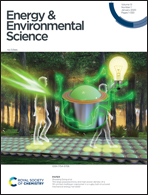High-purity pyrrole-type FeN4 sites as a superior oxygen reduction electrocatalyst†
Abstract
Atomically dispersed iron–nitrogen (FeN4) catalysts have emerged as the most promising alternative to costly Pt-based counterparts in proton exchange membrane fuel cells (PEMFCs), but often they suffer from high overpotential and poor stability due to the diverse iron–nitrogen coordination structure. Herein, we demonstrate high-purity pyrrole-type FeN4 sites for the first time, as a superior ORR electrocatalyst for PEMFCs. The high-purity pyrrole-type FeN4 catalyst exhibited extremely outstanding ORR activity with an ultra-high active area current density of 6.89 mA m−2 in acid medium, which exceeds that of most reported metal–nitrogen coordination catalysts. Experimental and theoretical analyses reveal that high-purity pyrrole-type coordination significantly modifies the atomic and electronic structures of FeN4 sites, bringing with it high intrinsic catalytic activity, preferable O2 adsorption energy and full four-electron reaction selectivity for ORR catalysis. Therefore, PEMFCs built with this high-purity FeN4 catalyst achieve a high open-circuit voltage (1.01 V) and a large peak power density (over 700 mW cm−2). High-purity iron–nitrogen coordination would give new insights into highly efficient electrocatalysts for PEMFCs.



 Please wait while we load your content...
Please wait while we load your content...